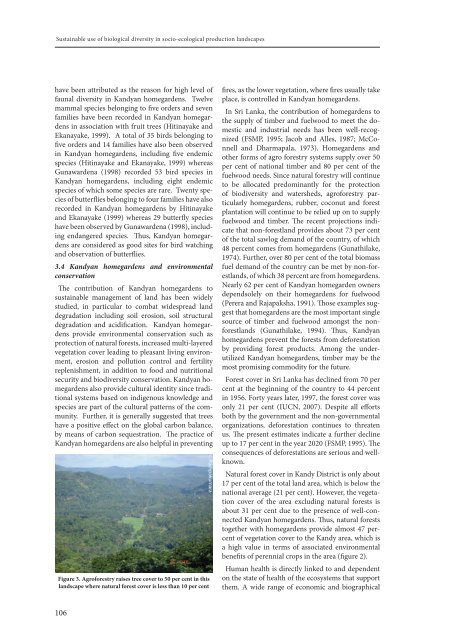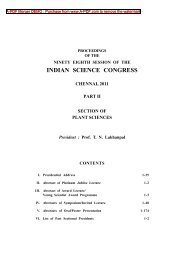sustainable use of biological diversity.pdf - India Environment Portal
sustainable use of biological diversity.pdf - India Environment Portal
sustainable use of biological diversity.pdf - India Environment Portal
You also want an ePaper? Increase the reach of your titles
YUMPU automatically turns print PDFs into web optimized ePapers that Google loves.
Sustainable <strong>use</strong> <strong>of</strong> <strong>biological</strong> <strong>diversity</strong> in socio-ecological production landscapes<br />
have been attributed as the reason for high level <strong>of</strong><br />
faunal <strong>diversity</strong> in Kandyan homegardens. Twelve<br />
mammal species belonging to five orders and seven<br />
families have been recorded in Kandyan homegardens<br />
in association with fruit trees (Hitinayake and<br />
Ekanayake, 1999). A total <strong>of</strong> 35 birds belonging to<br />
five orders and 14 families have also been observed<br />
in Kandyan homegardens, including five endemic<br />
species (Hitinayake and Ekanayake, 1999) whereas<br />
Gunawardena (1998) recorded 53 bird species in<br />
Kandyan homegardens, including eight endemic<br />
species <strong>of</strong> which some species are rare. Twenty species<br />
<strong>of</strong> butterflies belonging to four families have also<br />
recorded in Kandyan homegardens by Hitinayake<br />
and Ekanayake (1999) whereas 29 butterfly species<br />
have been observed by Gunawardena (1998), including<br />
endangered species. Thus, Kandyan homegardens<br />
are considered as good sites for bird watching<br />
and observation <strong>of</strong> butterflies.<br />
3.4 Kandyan homegardens and environmental<br />
conservation<br />
The contribution <strong>of</strong> Kandyan homegardens to<br />
<strong>sustainable</strong> management <strong>of</strong> land has been widely<br />
studied, in particular to combat widespread land<br />
degradation including soil erosion, soil structural<br />
degradation and acidification. Kandyan homegardens<br />
provide environmental conservation such as<br />
protection <strong>of</strong> natural forests, increased multi-layered<br />
vegetation cover leading to pleasant living environment,<br />
erosion and pollution control and fertility<br />
replenishment, in addition to food and nutritional<br />
security and bio<strong>diversity</strong> conservation. Kandyan homegardens<br />
also provide cultural identity since traditional<br />
systems based on indigenous knowledge and<br />
species are part <strong>of</strong> the cultural patterns <strong>of</strong> the community.<br />
Further, it is generally suggested that trees<br />
have a positive effect on the global carbon balance,<br />
by means <strong>of</strong> carbon sequestration. The practice <strong>of</strong><br />
Kandyan homegardens are also helpful in preventing<br />
figure 3. agr<strong>of</strong>orestry raises tree cover to 50 per cent in this<br />
landscape where natural forest cover is less than 10 per cent<br />
© Pushpakumara<br />
fires, as the lower vegetation, where fires usually take<br />
place, is controlled in Kandyan homegardens.<br />
In Sri Lanka, the contribution <strong>of</strong> homegardens to<br />
the supply <strong>of</strong> timber and fuelwood to meet the domestic<br />
and industrial needs has been well-recognized<br />
(FSMP, 1995; Jacob and Alles, 1987; McConnell<br />
and Dharmapala, 1973). Homegardens and<br />
other forms <strong>of</strong> agro forestry systems supply over 50<br />
per cent <strong>of</strong> national timber and 80 per cent <strong>of</strong> the<br />
fuelwood needs. Since natural forestry will continue<br />
to be allocated predominantly for the protection<br />
<strong>of</strong> bio<strong>diversity</strong> and watersheds, agr<strong>of</strong>orestry particularly<br />
homegardens, rubber, coconut and forest<br />
plantation will continue to be relied up on to supply<br />
fuelwood and timber. The recent projections indicate<br />
that non-forestland provides about 73 per cent<br />
<strong>of</strong> the total sawlog demand <strong>of</strong> the country, <strong>of</strong> which<br />
48 percent comes from homegardens (Gunathilake,<br />
1974). Further, over 80 per cent <strong>of</strong> the total biomass<br />
fuel demand <strong>of</strong> the country can be met by non-forestlands,<br />
<strong>of</strong> which 38 percent are from homegardens.<br />
Nearly 62 per cent <strong>of</strong> Kandyan homegarden owners<br />
dependsolely on their homegardens for fuelwood<br />
(Perera and Rajapaksha, 1991). Those examples suggest<br />
that homegardens are the most important single<br />
source <strong>of</strong> timber and fuelwood amongst the nonforestlands<br />
(Gunathilake, 1994). Thus, Kandyan<br />
homegardens prevent the forests from deforestation<br />
by providing forest products. Among the underutilized<br />
Kandyan homegardens, timber may be the<br />
most promising commodity for the future.<br />
Forest cover in Sri Lanka has declined from 70 per<br />
cent at the beginning <strong>of</strong> the country to 44 percent<br />
in 1956. Forty years later, 1997, the forest cover was<br />
only 21 per cent (IUCN, 2007). Despite all efforts<br />
both by the government and the non-governmental<br />
organizations, deforestation continues to threaten<br />
us. The present estimates indicate a further decline<br />
up to 17 per cent in the year 2020 (FSMP, 1995). The<br />
consequences <strong>of</strong> deforestations are serious and wellknown.<br />
Natural forest cover in Kandy District is only about<br />
17 per cent <strong>of</strong> the total land area, which is below the<br />
national average (21 per cent). However, the vegetation<br />
cover <strong>of</strong> the area excluding natural forests is<br />
about 31 per cent due to the presence <strong>of</strong> well-connected<br />
Kandyan homegardens. Thus, natural forests<br />
together with homegardens provide almost 47 percent<br />
<strong>of</strong> vegetation cover to the Kandy area, which is<br />
a high value in terms <strong>of</strong> associated environmental<br />
benefits <strong>of</strong> perennial crops in the area (figure 2).<br />
Human health is directly linked to and dependent<br />
on the state <strong>of</strong> health <strong>of</strong> the ecosystems that support<br />
them. A wide range <strong>of</strong> economic and biographical<br />
106
















